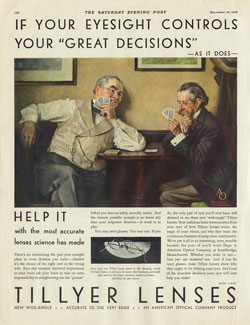 Image courtesy of Carl Zeiss Vision
Image courtesy of Carl Zeiss Vision
Even more puzzling to art collectors was the name of the painting. It’s called “If Your Eyesight Controls Your Great Decisions.” But once you know the name, you might notice that one of the card players—the smiling fellow who appears to be winning the game—is wearing a stylish pair of spectacles.
Yet the mystery remains: Why did Rockwell name the painting after the eyewear, a relatively small detail in the work?
These questions could have been easily answered by readers who first saw Rockwell’s painting in the December 14, 1929 issue of Saturday Evening Post. This million-dollar work appeared in an advertisement for American Optical, the leading provider of visioncare products in the United States at that juncture, and now part of Carl Zeiss Vision.
Archival images documenting the historic efforts of a major American artist to educate the public about visioncare needs and ophthalmic health are getting seen again thanks to the Optical Heritage Museum in Southbridge, Massachusetts. This unique organization has ramped up its activities in recent months, and is making a wide range of rare materials available, both online and in exhibits.
Rockwell’s evocative painting aimed to promote AO’s Tillyer Lens, the biggest innovation in consumer optics of the 1920s. The optimized performance of this lens offered crisper vision, especially in the periphery, and significantly reduced eyestrain. Although Rockwell’s work appeared in paid advertisements, the end result wasn’t dissimilar to the public service marketing of the current day.
“All these decades later, we are still addressing the same issues of public awareness about healthy vision,” remarked Zeiss vice president Karen Roberts. “But if Rockwell were painting about the subject today, he would probably depict someone using a tablet or a smartphone.”
Images courtesy of Carl Zeiss Vision.
Rockwell created six paintings for American Optical, although two of the originals may have been destroyed in a 1940s fire in the artist’s studio. But some of the supposedly destroyed works have later shown up at auction, and it’s possible that these two AO-commissioned works—featuring a student reading a schoolbook, and a stylish young lady in Jazz Age fashions—might eventually come to light.
In an interesting twist, Rockwell later moved to Massachusetts and lived within commuting distance of the American Optical headquarters and manufacturing operations in Southbridge, Massachusetts—the same city where the Optical Heritage Museum is now located. The artist’s works and legacy are now handled by the Norman Rockwell Museum in Stockbridge.
The collection there also includes American Optical eyeglasses worn by Norman Rockwell, and even the original package they came in when they arrived in the mail. “He not only painted AO eyewear,” remarked the museum’s executive director Dick Whitney, “he also used it every day in making his other famous works.”